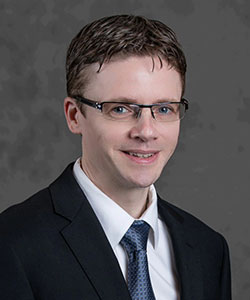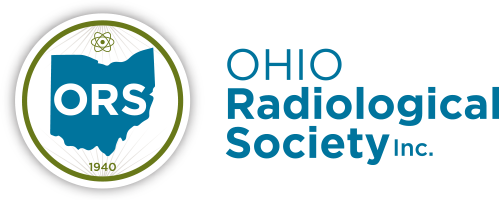The honor of being president of the Ohio Radiological Society has been shared by many respected colleagues, and I find myself humbly proud to hold this office. As a matter of introduction, I am a Neuroradiologist at Cleveland Clinic where I also specialize in localizing CSF leaks.
 I have served in many positions at the state and national level and currently also serve on the ACR Board of Chancellors as the Young and Early Career Professional Section (YPS) representative. I have learned a tremendous amount about the critical role of organized radiology in the advocacy of our profession over my years of involvement and have had the privilege of meeting with many exceptional leaders in radiology.
I have served in many positions at the state and national level and currently also serve on the ACR Board of Chancellors as the Young and Early Career Professional Section (YPS) representative. I have learned a tremendous amount about the critical role of organized radiology in the advocacy of our profession over my years of involvement and have had the privilege of meeting with many exceptional leaders in radiology.
At both the state and national level we are facing many challenges in radiology, namely the workforce shortage, ongoing Medicare reimbursement cuts, and scope of practice issues. To address these issues hundreds of ACR members met with members of Congress in person in Washington, DC where we discussed each issue and offered viable solutions through legislation.
For the workforce issue, this included the need to implement the Protecting Access to Medicare Act (PAMA) which established the Appropriate Use Criteria (AUC) program, aimed at decreasing the volume of low-value imaging by guiding providers toward the most appropriate exams and limiting patient exposure to unnecessary radiation. Estimates suggest this could provide savings to Medicare in the range of $2 billion over ten years and Medicare beneficiaries would also save about $1.4 billion over the current budget window via reduced cost-sharing.
We also asked each representative to cosponsor the Resident Physician Shortage Reduction Act (H.R. 2389/S. 1302) to increase the number of Medicare-supported Graduate Medical Education (GME) positions by lifting the artificial cap placed on these positions almost three decades ago, and to increase the number of federally supported medical residency positions by 2,000 annually for seven years.
We also requested each to cosponsor the Conrad State 30 and Physician Access Reauthorization Act (H.R. 4942/ S. 665). This program allows 30 qualified residents per state on J-1 visas to remain in the U.S. (rather than the current requirement to return to their home country for two years after residency) if they agree to practice in a medically underserved area for three years. This legislation would also increase the number of residents up to 45 if certain nationwide thresholds are met. Along similar lines, we asked each to cosponsor the Support the Healthcare Workforce Resilience Act (H.R. 6205/S.3211) which would initiate a one-time recapture of up to 40,000 unused employment-based visas (25,000 for foreign-born nurses and 15,000 for foreign-born physicians).
While we thanked our legislators for supporting physicians over the last four years by mitigating scheduled Medicare cuts, we also pushed to address both short and long-term relief for the Medicare Physician Fee Schedule (MPFS) to mitigate significant payment reductions resulting from the budget neutrality requirement. Thanks to our efforts, Congressional action added an additional 1.68% to the MPFS conversion factor (CF) beginning March 9 for the remainder of 2024, which combined with the already existing 1.25% CF increase passed at the end of 2022, resulted in a 2.93% increase. More importantly, given that the MPFS is one of the only fee schedules without a built-in inflationary update we asked members of Congress to cosponsor H.R. 2474, the Strengthening Medicare for Patients and Providers Act. This would add a permanent Medicare Economic Index (MEI) based inflationary update to the MPFS to provide long term financial stability to Medicare providers, thereby ensuring Medicare beneficiaries get the care they deserve.
Scope of practice issues are ongoing, but there is a growing threat to quality patient care by NPPs who, beyond the exam ordering appropriateness issues due to changes in the law introduced in 2000, are now also increasingly interpreting radiology exams without appropriate training or certification. From 2013-2022 office-based imaging interpretations by NPPs increased by 9% including CT, US, MRI, and NM exams. While there is some geographic variability, this is an extremely troubling trend with disastrous implications for patients if left unchecked. Thankfully the ACR offers substantial grant funding to chapters that apply to help fight specific scope creep issues at the state level.
The ACR’s government relations efforts spared radiology from 437 million dollars in imaging cuts in 2023. More impressively, from 2021-2023 the ACR prevented over 1.6 billion in proposed imaging cuts, which is approximately $41,000 per US radiologist. Clearly, we cannot afford these kinds of cuts in the face of rising costs of providing care to patients. Such achievements further solidify the ACR’s value to every member and should be a strong motivator to all potential members to join and support the ACR to build on these efforts.
Looking forward to the fact that we will continue to support legislation to address radiology’s key issues on our next meeting in Washington, DC. Garnering support for new house resolutions such as 6371 will go a long way to sustaining radiology and our ability to care for patients. These are just some of the ways that your dues support your profession. RADPAC and ORSPAC need your separate support as well, and I strongly encourage all to contribute to keep the fight going. Supporting these funds is essentially professional insurance and it is not something any of us can afford to be without.
I’d like to close by thanking our Ohio radiological Society Officers Natasha Monga, Allison Person, Robert Hobohm, Allan Chiunda, Paul Wong, and Yogesh Patel, our staff Julie Metheny, and our councilors Eric Bourekas, Kathryn Gardner, Paul Geis, David Griffith, Charles Martin, Michael Seider, Stuart Sorkin, all of our officers who also serve as councilors and all of our alternate councilors as well, the RFS and YPS members, and as always, Dr. John Olsen for keeping the organization strong.
David Mihal, MD
Cleveland Clinic – Neuroradiology


